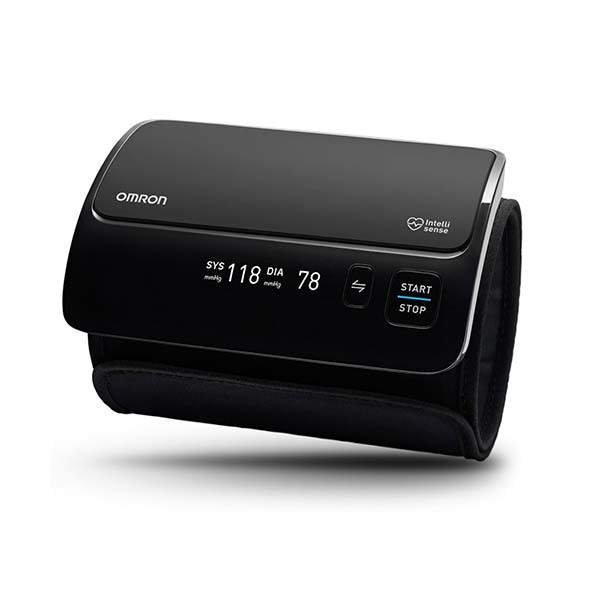product name
- Omron Evolve blood pressure monitor
Belongs to
- Medical devices - blood pressure measuring devices
the use
- This blood pressure monitor is easy to use, shows accurate and repeatable results
Product features
- All-in-one upper arm blood pressure monitor.
- No tubes, no wires.
- High ease of use.
- It can be used anytime and anywhere.
- Omron Intelli Wrap Cuff technology provides consistent, accurate measurements.
- It gives you accurate readings regardless of how the device is placed around the user's arm.
- You can read and follow readings via wireless connection to the Omron Connect app.
- Save and share the user's health data through the mobile application.
Instructions for use
- Make sure to follow the following instructions before applying blood pressure:
- Stop any exercise 30 minutes before the measurement.
- Do not drink any caffeinated beverages or smoke 30 minutes before the measurement.
- Empty your bladder of urine.
- Take a 5-minute rest period before measuring, keep your back straight, remove any tight clothing from the measurement area, and do not keep your feet intertwined.
- Do not talk during the measurement or during rest time.
- Measure twice, with an interval of two minutes, then take the average of the two measurements.
- To get accurate results, follow these steps:
- Before measuring your blood pressure, you must get enough rest and not suffer from any stress or anxiety before measuring your blood pressure
- Your feet should be on the floor and you should sit upright on a chair with your back against the back of the chair.
- Place your arm on the table and just make sure that your hand and arm are relaxed on the table. It is important not to close your fist too tightly when measuring blood pressure.
- Make sure you can place two fingers under the armband when placing it on your upper arm, and then adjust it so that the tube extends to the middle or slightly to the right of your arm
- When you check your blood pressure, don't talk and just relax. Press the device's power button, then press the start button.
- You will feel the cuff inflate very quickly. The position may be temporarily uncomfortable as the cuff automatically inflates and deflates, but this will only be for a short time. You can deflate the belt quickly by pressing the “Stop” button if it becomes too painful or uncomfortable.
- Write down the reading as soon as you receive it. These days, many blood pressure monitors have internal memory.
- After a few minutes of measuring your blood pressure, it is a good idea to check it again to make sure the readings are similar and accurate.
- If your doctor or pharmacist instructs you to check your blood pressure, do so twice daily, in the morning and evening, and then schedule a follow-up consultation with the results.
Security
- 3-year warranty for repair or replacement from the same pharmacy branch from which it was purchased.
What is high blood pressure?
- High blood pressure is a common condition in which the long-term force of blood pressure against the walls of your arteries is high enough that it can eventually cause health problems, such as heart disease.
- Lowering blood pressure reduces the risk of fatal and non-fatal cardiovascular diseases, especially strokes and myocardial infarction.
Useful tips to lower blood pressure
- You will also find the following non-drug treatments effective in lowering blood pressure:
- Lose excess weight and watch your waist circumference
- Exercise regularly
- Follow a healthy diet
- Reduce the amounts of sodium (found in table salt) in your diet
- Make sure to quit smoking
- Limit caffeine
- Avoid stress and psychological pressure
- Monitor your blood pressure at home constantly using blood pressure monitors
- Garlic or omega-3 supplements have been shown to be effective in lowering blood pressure in hypertensive patients
- Follow your blood pressure levels with your doctor on an ongoing basis
Normal levels of blood pressure
- The normal level of blood pressure is less than 120/80 mmHg
- High blood pressure: when the systolic pressure reading is 120-129 mmHg and the diastolic pressure is less than 80 mmHg
- Level 1 hypertension patient: When the systolic pressure reading is 130-139 mmHg or diastolic pressure is 80-89 mmHg
- Level 2 hypertension: When the blood pressure reading is 140/90 mmHg or more
- Hypertensive crisis, which is a serious condition that requires immediate referral to the hospital if the blood pressure is 180/120 mmHg or more.

